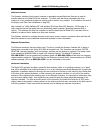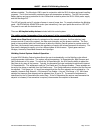
M4557 - Model 9210 Nitriding Controller
SSi Manual SERIES 9210-M4557-Nitriding Page 5 of 5
The power supply/controller should not be wired to a three phase supply with an unearthed star
connection. Under fault conditions such a supply could rise above 264Vac with respect to ground and the
product would not be safe.
Voltage transients across the power supply connections, and between the power supply and ground, must
not exceed 2.5kV. Where occasional voltage transients over 2.5kV are expected or measured, the power
installation to both the instrument supply and load circuits should include a transient limiting device.
These units will typically include gas discharge tubes and metal oxide varistors that limit and control volt
age transients on the supply line due to lightning strikes or inductive load switching. Devices are available
in a range of energy ratings and should be selected to suit conditions at the installation.
•
Conductive pollution
- Electrically conductive pollution must be excluded from the cabinet in which the
controller is mounted. For example, carbon dust is a form of electrically conductive pollution. To secure
a suitable atmosphere in conditions of conductive pollution, fit an air filter to the air intake of the
cabinet. Where condensation is likely, for example at low temperatures, include a thermostatically
controlled heater in the cabinet.
•
Over-temperature protection
- When designing any control system it is essential to consider what will
happen if any part of the system should fail. In temperature control applications the primary danger is
that the heating will remain constantly on. Apart from spoiling the product, this could damage any
process machinery being controlled or even cause a fire. Reasons why the heating might remain
constantly on include:
• the temperature sensor becoming detached from the process
• thermocouple wiring becoming a short circuit
• the controller failing with its heating output constantly on
• an external valve or contactor sticking in the heating condition
• the controller setpoint set too high
Where damage or injury is possible, we recommend fitting a separate over-temperature protection unit,
with an independent temperature sensor, which will isolate the heating circuit. Please note that the alarm
relays within the controller will not give protection under all failure conditions.
•
Grounding of the temperature sensor shield
- In some installations it is common practice to replace the
temperature sensor while the controller is still powered up. Under these conditions, as additional
protection against electric shock, we recommend that the shield of the temperature sensor be
grounded. Do not rely on grounding through the framework of the machine.
•
Installation requirements for EMC
- To ensure compliance with the European EMC directive certain
installation precautions are necessary. When using relay or triac outputs it may be necessary to fit a
filter suitable for suppressing the emissions. The filter requirements will depend on t he type of load.
For typical applications we recommend Schaffner FN321 or FN612.
•
Routing of wires
- To minimize the pick-up of electrical noise, the wiring for low voltage DC and
particularly the sensor input should be routed away from high-current power cables. Where it is
impractical to do this, use shielded cables with the shield grounded at one end.


















